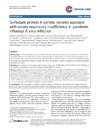Please use this identifier to cite or link to this item:
https://accedacris.ulpgc.es/jspui/handle/10553/46576
| Title: | Surfactant protein A genetic variants associate with severe respiratory insufficiency in pandemic influenza A virus infection | Authors: | Herrera-Ramos, Estefanía López-Rodríguez, Marta Ruiz Hernández, José J. Horcajada, Juan P. Borderías, Luis Lerma, Elisabeth Blanquer, José Pérez-González, María C. García-Laorden, María I. Florido, Yanira Mas-Bosch, Virginia Montero, Milagro Ferrer, José M. Sorlí, Luisa Vilaplana, Carlos Rajas, Olga Briones, Marisa Aspa, Javier López-Granados, Eduardo Solé-Violán, Jordi de Castro, Felipe R. Rodríguez-Gallego, Carlos |
UNESCO Clasification: | 32 Ciencias médicas 2409 Genética |
Keywords: | H1N1 Influenza Ozone Exposure Collectins Polymorphisms Definitions, et al |
Issue Date: | 2014 | Journal: | Critical Care | Abstract: | Introduction: Inherited variability in host immune responses influences susceptibility and outcome of Influenza A virus (IAV) infection, but these factors remain largely unknown. Components of the innate immune response may be crucial in the first days of the infection. The collectins surfactant protein (SP)-A1, -A2, and -D and mannose-binding lectin (MBL) neutralize IAV infectivity, although only SP-A2 can establish an efficient neutralization of poorly glycosylated pandemic IAV strains.Methods: We studied the role of polymorphic variants at the genes of MBL (MBL2), SP-A1 (SFTPA1), SP-A2 (SFTPA2), and SP-D (SFTPD) in 93 patients with H1N1 pandemic 2009 (H1N1pdm) infection.Results: Multivariate analysis showed that two frequent SFTPA2 missense alleles (rs1965708-C and rs1059046-A) and the SFTPA2 haplotype 1A(0) were associated with a need for mechanical ventilation, acute respiratory failure, and acute respiratory distress syndrome. The SFTPA2 haplotype 1A(1) was a protective variant. Kaplan-Meier analysis and Cox regression also showed that diplotypes not containing the 1A(1) haplotype were associated with a significantly shorter time to ICU admission in hospitalized patients. In addition, rs1965708-C (P = 0.0007), rs1059046-A (P = 0.0007), and haplotype 1A(0) (P = 0.0004) were associated, in a dose-dependent fashion, with lower PaO2/FiO(2) ratio, whereas haplotype 1A(1) was associated with a higher PaO2/FiO(2) ratio (P = 0.001).Conclusions: Our data suggest an effect of genetic variants of SFTPA2 on the severity of H1N1pdm infection and could pave the way for a potential treatment with haplotype-specific (1A(1)) SP-A2 for future IAV pandemics. | URI: | https://accedacris.ulpgc.es/handle/10553/46576 | ISSN: | 1364-8535 | DOI: | 10.1186/cc13934 | Source: | Critical Care [ISSN 1364-8535],v. 18, R127, (Junio 2014) |
| Appears in Collections: | Artículos |
SCOPUSTM
Citations
50
checked on Jun 8, 2025
WEB OF SCIENCETM
Citations
50
checked on Jun 8, 2025
Page view(s)
121
checked on Jul 13, 2024
Download(s)
133
checked on Jul 13, 2024
Google ScholarTM
Check
Altmetric
Share
Export metadata
Items in accedaCRIS are protected by copyright, with all rights reserved, unless otherwise indicated.
